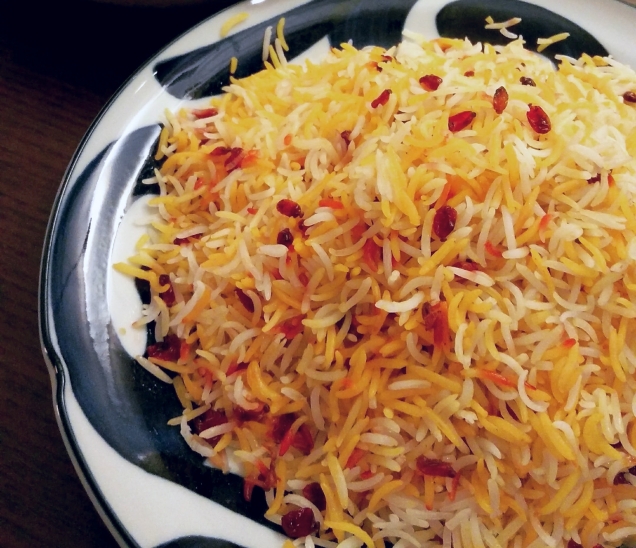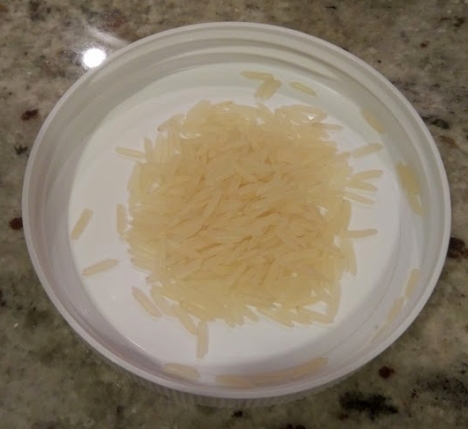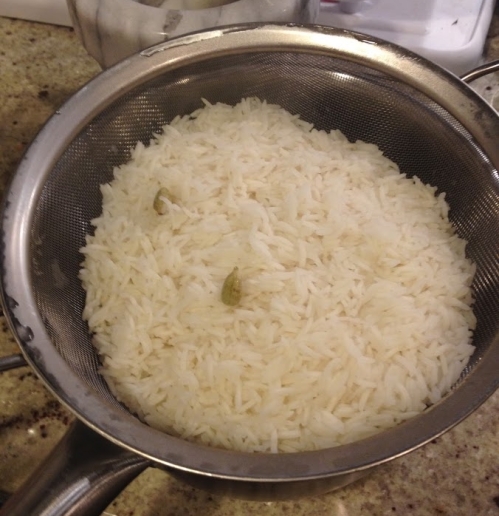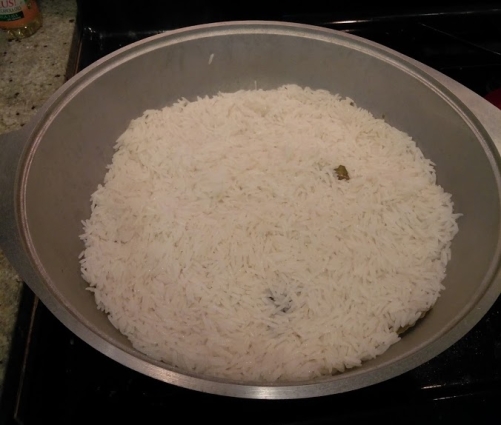
Today’s post is all about how to make fluffy basmati rice like you may have tried in Indian or Persian restaurants. This style of rice cooking is used to make plov/chelow/polow/pulao in Iran, Azerbaijan, and the Indian subcontinent. Unlike the method used for Uzbek plov where the rice is cooked together with other ingredients and absorbs the broth, in the “drain and steam” method, the rice is cooked by itself, drained, then steamed. This ensures fluffy rice and individual grains that don’t stick to each other. We’ll go over specific recipes with this rice, like Hyderabadi biryani or Azeri plov, in another post.

For a long time, I would buy basmati rice in the store, cook it, and find it tasted nothing like the fluffy rice in Indian restaurants. The secret to making perfectly fluffy basmati rice is 1) using a high quality rice, 2) draining and 3) steaming.
Importantly, a rice cooker will NOT make fluffy basmati rice! Rice cookers are pretty much only for making Asian varieties of rice which are eaten somewhat sticky. If you use a rice cooker to make basmati rice, it will probably come out kind of sticky or mushy, and it won’t resemble the rice in Indian restaurants.
Secondly, sometimes people recommend the “absorption” technique where you boil the rice in the correct amount of water then cover it and let it “absorb” the water and steam until fully cooked. That method works fine only if you cook the exact same type of rice and the exact same amount of rice every time under the exact same conditions, and is best only for cooking small amounts. It is highly prone to error and can result in overcooked or undercooked rice if you get the amount of water wrong. To achieve perfectly fluffy rice every time for any amount of rice, use the drain and steam method explained below. However, sometimes a recipe will call for the absorption method because the rice is being flavored by the broth (e.g. Saudi kabsa). We’ll address the fine points of that method in a later post.


I use two types of basmati rice: the regular kind (e.g. Tilda brand) and the “sella” (sometimes called “sela”) kind. Regular basmati rice is the best type to eat plain with curries, and has a nice aroma to it – but it is rather delicate and the grains can break easily, so you must be very careful with it when cooking. “Sella” rice is good to use for biryanis. It is parboiled, giving it a yellowish translucent color, and making it very resilient and non-sticky. It is nearly impossible to cook it wrong. The downside of “sella” rice is that it does not absorb flavors that well and is a bit rubbery tasting compared to the delicate regular basmati rice. If you have never cooked rice like this before, I recommend starting with “sella” as it is a bit more forgiving. Kalustyan’s in NYC sells both varieties.
Whatever kind you buy, make sure it is a high quality brand, rather than a generic “basmati” rice you find in the store.
Process:
1)Wash your basmati rice several times until the water runs clear. Then soak the rice for 20-30 minutes. Drain the rice after you are done soaking it.
2)Pour water over the rice until 2-3 inches of water cover the rice. Add salt and oil to taste. If you are making Indian style rice, you can put in cardamom, bay leaf, and other whole spices as you like. Set this on high heat until you get a rolling boil.

3)Let the rice cook in the boiling water for a few minutes, sampling a rice grain every now and then. The rice needs to taste 70-80% done – a bit crunchy, but nearly edible.
4)Quickly, drain the rice in a colander. Do not let it sit in the colander long, otherwise it will start to clump up!

For Azeri or Persian rice, you may want to make a kazmakh(Azeri) or tah-dig(Persian) – the rice that turns crispy from touching the pot. Getting this right will involve trial and error and most likely it will just stick to the pot without coming off cleanly. Mix some yogurt and egg in a bowl, and add some of the mixed rice. The mixture should be mostly rice, and not too liquid.
You can also make a saffron infusion to add color and flavor (if you just want the yellow color, turmeric will give the same effect and is much cheaper). Just grind up some saffron stalks and mix with hot water.

5)Now we start the steaming phase, but don’t turn the heat on for now. Ready an empty pot – a kazan works best if you have one, but just use a regular pot otherwise (don’t use a wok!). If you made a kazmakh or tah-dig, spread it in a layer over the bottom of your pot. Then put the drained rice into the pot, and form it into a mountain. If making Azeri or Persian rice, you can drizzle some saffron-infused water over it.

6)Now you need to bundle up your pot so the steam can stay inside. Put clean cloth towels between the lid and the pot, and close tightly (paper towels can do in a pinch if you don’t have any towels lying about). Weigh down the lid with a bowl or other heavy object – we don’t want any steam to escape.

7)Now turn the heat to medium and let the rice pot warm up for about 5 minutes. Then turn this to minimum heat, and let it steam for at least 20 minutes, ideally 30 minutes or even longer. More steaming = fluffier rice.
8)If making Azeri rice, you can open up the pot after 15-20 minutes, put a big slab of butter in the middle of your mountain, then wrap it up again and let it steam for another 20-30 minutes.

9)When you are done steaming, turn off the heat and let it sit covered for another 5 minutes. Then open the lid (being careful not to burn yourself on the escaping steam) and fluff up the rice a bit with a fork. Let it sit uncovered for another few minutes so the rice can cool down and firm up. For Indian rice, you may want to add a touch more oil after the rice is done cooking and mix well. If you made a kazmakh/tah-dig, pry it out with a knife and serve it with the rice.
